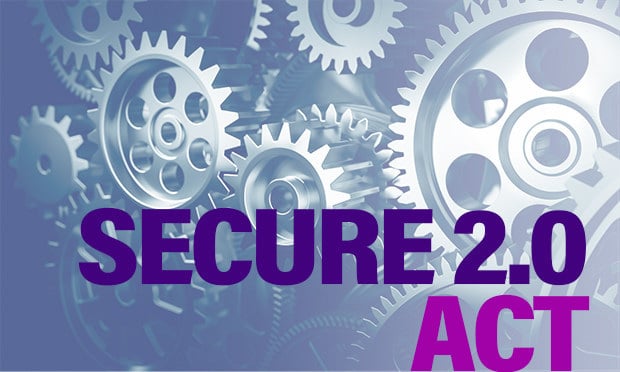 SECURE 2.0 Act
SECURE 2.0 Act
After months of deliberations, negotiations, and debates, the SECURE Act 2.0 is now law, having been ratified as part of the Consolidated Appropriations Act signed in December 2022.
SECURE 2.0 contains several significant changes to the U.S. retirement system — with the ultimate goal of helping Americans bolster retirement savings. While these changes are positive, plan sponsors now have the daunting task of complying with the new regulations.
Recommended For You
Related: SECURE 2.0: Key provisions for plan sponsors
What can make this especially challenging is that the majority of the new regulations go into effect over a span of the next one to three years and impact a vast spectrum of topics — such as contribution limits, age limits, participation requirements, and plan design provisions, to name a few. Below are some recommendations that can help ease the burden for plan sponsors as they navigate these new changes.
- Create a compliance calendar. Creating a compliance calendar can help plan sponsors adhere to the provisions in a timely fashion and avoid inadvertently making the required changes too late, or too early. Additionally, certain provisions go into effect based on the plan year and some go into effect based on the calendar year. While this may be the same date in most cases, plan sponsors with fiscal year-end plans should be especially diligent to comply with the proper dates.
- Maintain accurate census information. SECURE 2.0 contains several provisions that may impact participants of a certain age or employment status. This includes an increase to the age in which employees are required to take required minimum distributions, enhanced catch-up contributions for those between ages 60 and 63 and mandatory automatic enrollment for new hires. These changes, and new requirements for allowing part-time employees to participate in employer-sponsored plans earlier, will be much easier to administer if birth dates, hire dates, and employment status are accurate.
- Collaborate with payroll providers. Plan sponsors shouldn't hesitate to begin discussions with payroll providers regarding the SECURE 2.0 changes. Along with the significant cost of living increases to contribution limits for 2023, enhancements to catch-up contributions, new requirements to have certain catch-up contributions designated as Roth, the ability for employees to elect Roth-sourced employer contributions, and more, plan sponsors should confirm their payroll providers can handle these significant changes and verify the new limits are correctly accounted for.
- Update the plan document. While most of the new SECURE 2.0 terms are mandatory regulatory changes, there are some changes that will require plan sponsors to "opt-in" for their plan. For example, a plan sponsor's ability to make matching contributions to an employee's retirement account based on student loan repayments rather than matching employee retirement contributions. This can be an attractive benefit for younger people and plan sponsors may be eager to add this provision for recruiting efforts. However, before doing so, plan sponsors should formally amend their plan document to allow this provision.
- Educate employees. Plan sponsors have a fiduciary responsibility to participants and there is a lot of new information to absorb. Employers should educate employees on these significant changes so they can make informed decisions about their retirement goals. Many third-party administrators and investment advisors will likely be offering educational sessions in the form of webinars and one-on-one meetings as these changes become effective.
Steve Villecco is Principal at CliftonLarsonAllen LLP.
© 2025 ALM Global, LLC, All Rights Reserved. Request academic re-use from www.copyright.com. All other uses, submit a request to [email protected]. For more information visit Asset & Logo Licensing.







